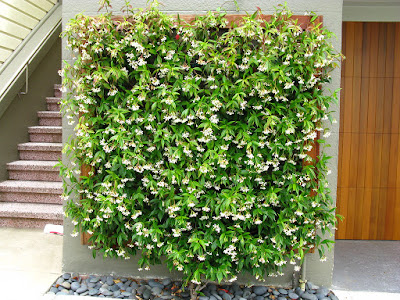Trachelospermum jasminoides, known as confederate jasmine, southern jasmine, star jasmine, confederate jessamine, Chinese star jasmine, is a woody climbing plant related to Chinese periwinkles, famous for perfume penetrating both spicy and sweet with small white flowers...
Trachelospermum jasminoides, known as confederate jasmine, southern jasmine, star jasmine, confederate jessamine, Chinese star jasmine, is a woody climbing plant related to Chinese periwinkles, famous for perfume penetrating both spicy and sweet with small white flowers. Remarkable for its vigor, it develops long twining stems lined with persistent foliage and shiny, leathery, sometimes taking beautiful red hues. In June-July, its bloom is able to embalm an entire area of the garden, without being as heady as that of real jasmine. Rustic in California and also particularly in the Southeastern United States in a sheltered location, the star jasmine is also grown very well in a large tray to elegantly dress the terrace or balcony. Further south, it settles in the ground, in the sun or in the shade, where it will be resistant to the summer drought once well installed.
Trachelospermum jasminoides description:
The star jasmine is a climbing or creeping plant of the family Apocynaceae, cousin of periwinkles, but also of Alamanda and Mandevilla. Its origins are in China, Japan, Korea and Vietnam, where it grows on the edge of the forest and among the underbrush. A little long to settle, the plant develops long stems that lignify quickly, its persistent vegetation can cover over 8m in all directions, in a favorable climate. The twigs are lined with opposite leaves, with an entire limb, oval in shape with a pointed end. They are thick and leathery, glazed, bright green, more or less dark depending on the nature of the soil. Their size varies from 5 to 12 cm in length, 2 to 4 cm in width.
When the plant suffers, more intense in mid-shade than in the sun, then they fall. When conditions become more favorable, new ones appear to replace them. The twining twigs meeting a moist surface emit aerial roots that allow the plant to cling to walls, soil or stones, like ivy.
The major asset of Trachelospermum jasminoides is its flowering, abundant from May to July depending on the climate, and especially divinely scented. The flowers are grouped in small clusters in the axils of the leaves and at the ends of the twigs. The turbinate button blossoms into a short corolla with a short tube that flares out and divides into 5 narrow petals, arranged in a helix. The diameter of the flowers reaches 2 to 3 cm. The fruit, seldom observed in our latitudes, brings to maturity seeds with an egret. Like many plants of the family Apocynaceae, southern jasmine contains alkaloids toxic to humans.
Grow and care Trachelospermum jasminoides:
Moderately hardy, Trachelospermum jasminoides will tolerate in the temperatures of -10 ° C to -15 ° C, planted in a sunny position and in a very well drained soil. In a milder climate, its culture is not a problem. Although it is most often used to climb walls or climb fences, it can also form an excellent ground cover, even in the shade of fallen trees, as an alternative to ivy. Perfect for growing a hedge between evergreens or masking an unpleasant view, star jasmine can also form a nice permanent tunnel, passage between two areas of the garden; it can be hoisted on a structure made with two arches joined by son. It can also feast the edge of a staircase, crown the embankment of a hollow road... At its foot you can grow orange trees of Mexico, Lavateres shrubs, ceanothe rampant. Its branches will mingle with those of clematis, honeysuckle or climbing Solanum in mild climate.
The best time to plantation is March, April, September and October. Choose a sunny or semi-shade exposure, even in the shade where it will however be a little less floriferous, in a deep soil, flexible and healthy, well drained, sheltered from cold winds. It supports -10 ° C, even punctually -15 °, but will withstand the strongest gels better if the foliage is protected from a wintering veil and the soil rather dry. This plant accepts limestone well, provided that there is no excess moisture in winter; in heavy soil and asphyxiating, it can show symptoms of chlorosis (leaves gradually turning yellow from the periphery, the veins remaining green).
Water in the summer or in case of drought during the first two years, to help the plant to settle. Once the roots have plunged deep enough into the soil, the plant will manage on its own, even in the case of a very dry summer. During growth, water once or twice a week and bring a liquid fertilizer twice a month. In autumn, a slow-release organic fertilizer can be brought and slightly buried by scratching at the foot of the plant, from the second year. You can prune it at the end of winter to control its development, or after each flowering.

















Can any of these JASMINE grow in lrge pots I have a roof garden and want to cover a storage shed.TIA
DeleteYeah, u can grow its in pots!
Delete